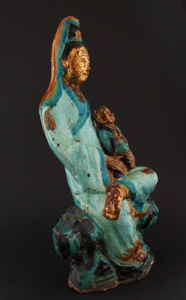
MING DYNASTY 1368 – 1644 Ming Fahau Ware
A Late Ming Fahua Stoneware Figure of Guanyin c.1600-1640. She is Shown in a Seated Position Holding a Child. The Figure and Child are Glazed Except for the Skin Which has Been Left in the Biscuit and then has Been Gilded Over a Brown Ground.
SOLD
- Condition
- Good, some areas of glaze loss which have filled with a brown pigment, there are traces of gilding remaining. The rocks show some traces of blue over-painting. A small chip to the lower edge.
- Size
- Height : 35 cm (13 3/4 inches)
- Provenance
- Old label to the back "Period Keen Lung" and in a different hand "1736-95".
- Stock number
- 23812
- References
- A very similar Fahua figure at the British Museum, dated to c.1628-1700, is illustrated in : Catalogue of Late Yuan and Ming Ceramic in the British Museum.(Jessica Harrison-Hall.The British Museum Press, 2001. ISBN 0-7141-1488-X.) page 429, item 13:41. For another figure of this type, dated to the 17th century, see ; An Important Collection of Chinese Ceramics, Christie`s London, 12th and 13th of May 1986, lot 61. For two very similar groups of this model from the collection of Robert Henry Benson (1850-1929) see our `Sold Items` numbers 22434 and 22435.
Information
Fahau Palette :
Fahua is really a colour scheme but it is also referred to as Fahua ware. It is normally either pottery or stoneware with a low fired vitreous glaze often with the highly fluxed colours separated by thin walls of clay in the manner of cloisonné. It was first Made in Shanxi Province during the Yuan Dynasty but later, from the Ming Dynasty, the Jingdezhen Kilns produced a Fahua Glazed Porcelain.
Guanyin :
Figures of Guanyin are some of the most commonly encountered images in Chinese figurative art. Guanyin was the Goddess of mercy. Her origins stem from Tibetan Buddhism, she was originally the patron saint of Tibetan Buddhism `Avalokitesvara`. Guanyin is actually the shorter form of the name Guan shi yin, which means “one who observes the voices of the world.” True to her name, Guanyin listens to and understands the worries that plague man`s existence. Because of her mercy and generosity, Guanyin is the most-loved of China`s divinities, the one people turn to for assistance in their everyday lives. Guanyin is specially venerated by those who are hoping to have children or those who are about to set out for sea. Guanyin has been said to have some of the same qualities as the Virgin Mary of Catholic theology, like the Virgin Mary she is sometimes portrayed holding a child in her arms, indeed she was associated with fecundity and given the title `Giver of Sons`. Guanyin is usually portrayed wearing a white cape. In her right hand. On her head is a crown in the style of the Amitabha-buddha, she is normally shown meditating in a seated position. While the worship of Guanyin can be traced back historically to India, she is the star of countless legends and folk tales in China. Guanyin`s home on earth was the Putuo mountains, located on an island on China`s eastern coast to the south of Shanghai. In China, Putuo-shan is one of the most sacred places in Buddhism and the temple dedicated to Guanyin on the mountain is one of the most important pilgrimage site for Buddhists and non-Buddhists alike. Guanyin`s birth is celebrated on the 19th day of February, and her enlightenment is celebrated on the 19th of September. On those days, the pilgrims flock to Putuo mountain.






